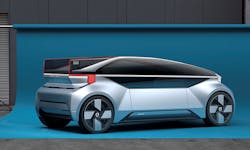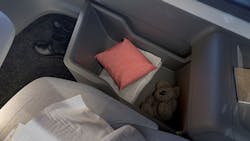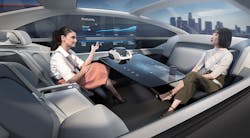Volvo’s Concept Car: How Self-Driving Vehicles Will Change the Way We Travel
With the debut of the 360c concept, Volvo has revealed the company’s vision for the future of travel: autonomous, electric, connected, and safe. Volvo claims the fully self-driving concept “capitalizes on the freedom in design afforded by the absence of a steering wheel and a combustion engine, providing the ability to re-imagine the traditional placement of passengers in rows of two or three.”
The Gothenburg, Sweden carmaker foresees several basic usage scenarios for a car like its 360c. It can serve as a mobile bedroom that could rival air, bus, and train providers; in particular, replacing red-eye flights with a smoother, calmer, possibly quicker, and more environmentally friendly travel option.
In fact, it may well serve as a competitor to short-haul air travel without the inconvenience of airport security, queues, and noisy and cramped airliners. A safety blanket included in the sleeping area incorporates a restraining system that works like a three-point safety belt but can be adjusted to people lying down while traveling.
(a)
(b)
(c)
(d)
The Volvo 360c (a) enables different potential uses of autonomous driving vehicles: a sleeping environment (b), mobile office (c) or dining room (d).
Second, the 360c could turn your work commute into a much more productive time, offering the connectivity and space of a mobile office. “People becoming less reliant on proximity to cities is just one example of the impact of removing the burden of unproductive travel time,” says product strategy chief Marten Levenstam, adding “The 360c driving office makes it viable for people to live at greater distances from crowded cities and use their time both in a more pleasant and more effective way.”
Third, it can be your living room and entertainment space. A modular interior with relevant information projected onto the windows makes flexibility the overriding characteristic of the 360c’s functionality.
How Safe Is It?
With all of the talk about autonomous cars, an obvious question arises: “How will they safely share the road with conventional vehicles? In a statement, Volvo said: “Autonomous drive and safety are closely linked, and the technology has the potential to deliver the most significant improvement in traffic safety since Volvo Cars invented the three-point safety belt in 1959.”
However, the company points out that autonomous technology will be introduced gradually rather than overnight. “As a result, fully autonomous cars will be introduced in a mixed traffic situation where driverless cars without a human driver will share the road with other road users. In such a traffic situation, it will no longer be possible to make eye contact with and learn about another driver’s intentions, a central element of today’s everyday traffic interaction.”
Instead, according to Volvo’s Levenstam, “The 360c explores what becomes possible when we remove the human driver, using new freedoms in design and recapturing time. It’s a glimpse at how autonomous drive technology will change the world as we know it.”
For example, the 360c uses lights, sound, and movement to communicate the vehicle’s intentions, making it clear what the car will do next. There are information readouts at the front of the car, placed right next to the LED headlights. Integrated below them is a black bar containing radar detectors, 3D cameras, and a laser sensor. Another sensor bar is placed on the back of the vehicle and a 360-degree strip of LED lights around the car lights up in different ways to communicate with pedestrians as well as other cars and drivers.
These displays convey the following information:
- The vehicle is powered up and autonomous mode is active.
- It intends to move from a stationary position or change direction.
- It senses a cyclist or pedestrian nearby.
- It’s trying to alert anyone who might be in the car’s path.
Volvo’s focus is to create a universal signaling standard “so that other road users do not have to consider the make or brand of individual autonomous cars.” The company is quick to note “but it is also important that we do not instruct others what to do next, in order to avoid potential confusion. Our research shows this is the safest way for fully autonomous cars to communicate with other road users.”
When the 360c is used in a ride-hailing scenario the fins at the back will function as a second information board, indicating a reservation number. Therefore, if multiple Lyft or Uber vehicles show up at the same spot, the customer knows which one is their ride.





